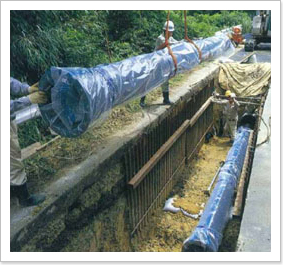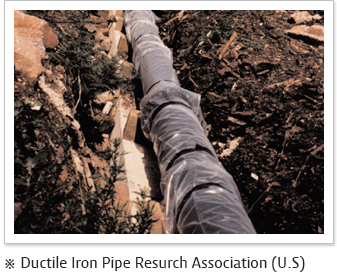
 >
> 




| Soil | Osaka | Osaka | Fukuoka | Sapporo | Yokohama |
|---|---|---|---|---|---|
| Soil | Reclaimed land | Reclaimed land | Reclaimed land | Reclaimed land | Reclaimed land |
| Soil character | Clayer soil (seawater effect) |
Sand (seawater effect) |
Clayer soil (seawater effect) |
Marine clay | Marine clay |
| Pipe Size | 400 | 100, 200 | 500 | 100 | 100 |
| laying period (year) | 20 | 19 | 29 | 16 | 14 |
| ANSI (soil evaluation) | 15.5 | 12.0 | 15.5 | 15.5 | 14.5 |
| Inspection | No corrosion | No corrosion | No corrosion | No corrosion | No corrosion |


| Pipe Condition | Number of Specimens | Mena Deepest Pitting Rate(in./yr.) | Years to Penetration |
|---|---|---|---|
| Sand Blasted (annealing oxide layer removed) |
102 | 0.025 | 10 |
| Bare (uncoated) | 22 | 0.0151 | 17 |
| As-manufactured (Standard Shop Coating) | 103 | 0.0151 | 24 |
| Polyethylene Encased | 150 | 0.00045 | 556 |